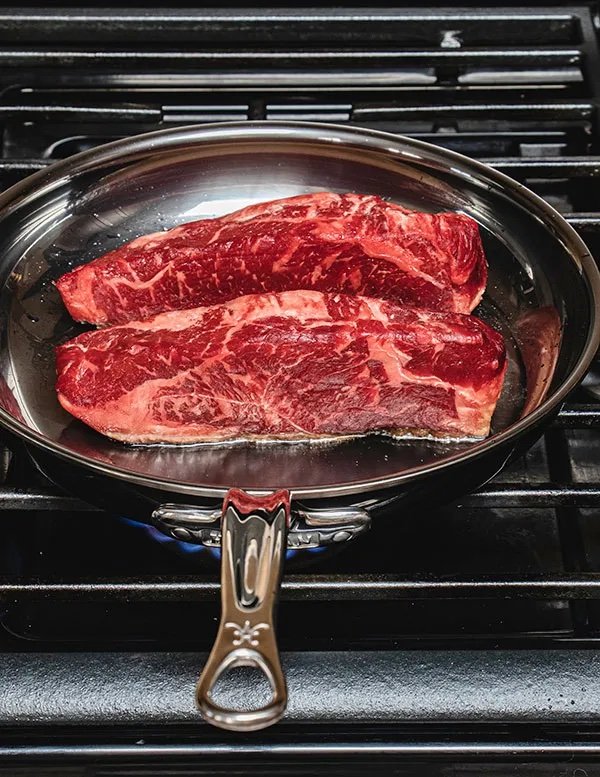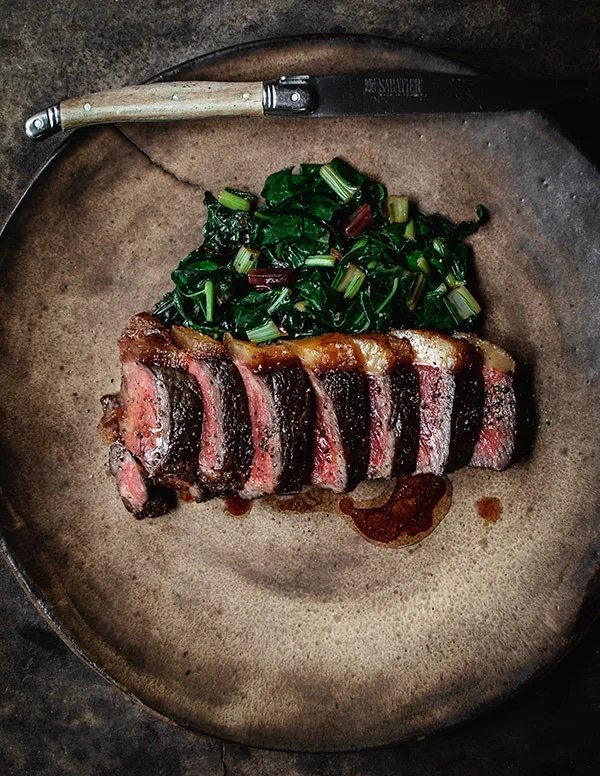Pan-Seared Grass Fed Steaks
Sponsored by Roam Butcher Shop and Hestan CulinaryA perfectly pan-seared grass-fed steak is the holy grail of meat-eaters: an evenly browned, crisp crust while maintaining a moist and juicy interior is the goal. For this recipe, we use a Hestan Nanobond Titanium skillet for cooking these beautifully marbled NY Strip steaks from Roam Butcher Shop to perfection.
We go back and forth on whether a NY strip or ribeye steak would be on our desert island dinner list, but one thing is for sure, it’s absolutely steak, not pork, chicken, or fish, and there is a big plate of shoestring fries alongside. Plus, chocolate pot creme for dessert.
We’re leaning towards NY strip steaks after Roam Butcher Shop (part of the Roam Artisan Burger group of restaurants) gifted us these glorious slabs of meat. Not only do they have a nice thick layer of fat along the edge, but these steaks are also richly marbled, which is an indicator of how intensely beefy they are going to taste. And did we mention these steaks are from pasture-raised 100% grass-fed beef? It’s rare to see grass-fed beef that is so beautifully marbled.
The thick strip of fat the butchers left intact is appreciated. We started these steaks out in the pan, edge sides down to render the fat for cooking. We’ve been doing this technique forever since we first read about it in a 2002 NY Times recipe from famed French chef Alain Ducasse:
Photo: Bruce Cole
Note: grass-fed beef fat has a high smoke point and as much as five times the amount of omega-3 fatty acids as grain-fed beef (in other words it’s good for you).
“Then I do something you will consider truly strange: I start by cooking the steak on its narrow side. I want to begin with the rim of fat on the edge, to render it so there is good, flavorful fat in the pan for the rest of the cooking. I’m also browning it so the finished steak will look immensely appetizing when it is served. ”
Ducasse also mentions cooking his steaks over moderate heat because he’s not trying to carbonize or char the surface. We’re cooking these steaks over medium-high heat in a Hestan Nanobonded skillet, which is hands-down the first pan we reach for when frying, sauteing, or stir-frying, and we even cook our omelets in it (and no, they don’t stick, more on that later). The NanoBond cookware’s triple-bonded stainless-steel base delivers quick, even heating with exacting temperature control that cooks rely on, essential for searing meat, poultry, and seafood.
A perfectly browned steak is the holy grail of meat-eaters. As Harold McGee says in his book On Food and Cooking, you can quickly achieve this result (most commonly referred to as the Maillard reaction) by cooking with medium heat and flipping steaks frequently, about every 15-30 seconds. But what does the Malliard reaction produce?
““One of the most important flavor-producing reactions in cooking is the Maillard reaction. It is sometimes called the “browning reaction” in discussions of cooking, but that description is incomplete at best. The important thing about the Maillard reaction isn’t the color, it’s the flavors and aromas. Indeed, it should be called ‘the flavor reaction,’ not the ‘browning reaction.’””
Flipping the steaks frequently is the other technique we religiously adhere to. Turning them every half minute or so means that the surface temperature of the steaks doesn’t cool down, and not only will you get more evenly browned meat, it will cook more quickly. Says Kenji Lopez-Alt:
“By flipping a steak multiple times—as often as once every 15 seconds or so—you not only end up with meat that’s more evenly cooked, you also cut down on your cook time by as much as a third, and develop a great crust on top of that. This is because with multiple flips, neither side is exposed to intense heat for too long, nor does it lose much heat to the relatively cool air above. It’s the equivalent of cooking it from both directions simultaneously. ”
We finished these steaks by basting them with butter and deglazing the pan by sautéing swiss chard to soak up all the browned and caramelized bits left behind.



